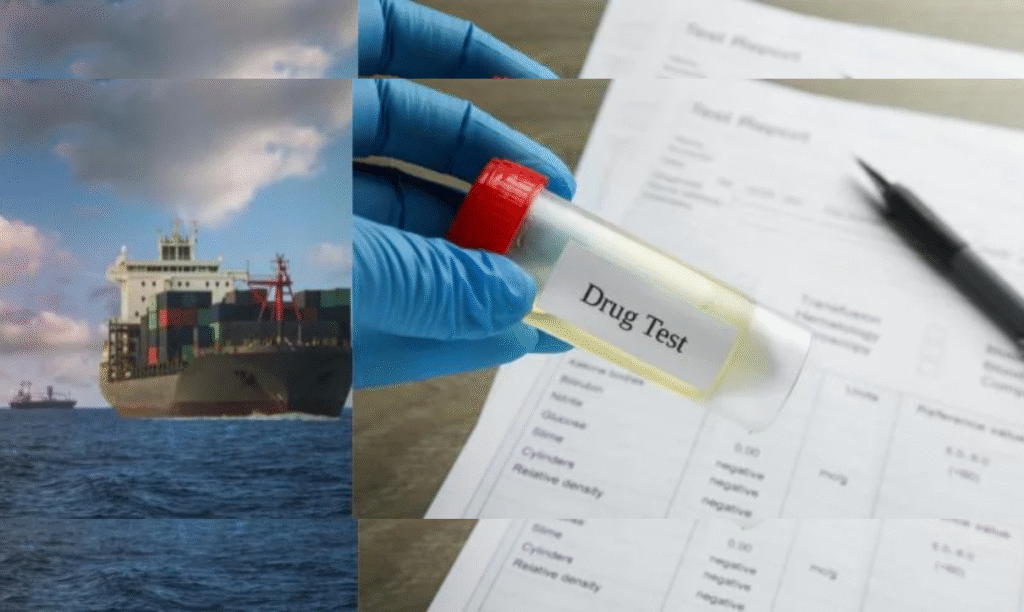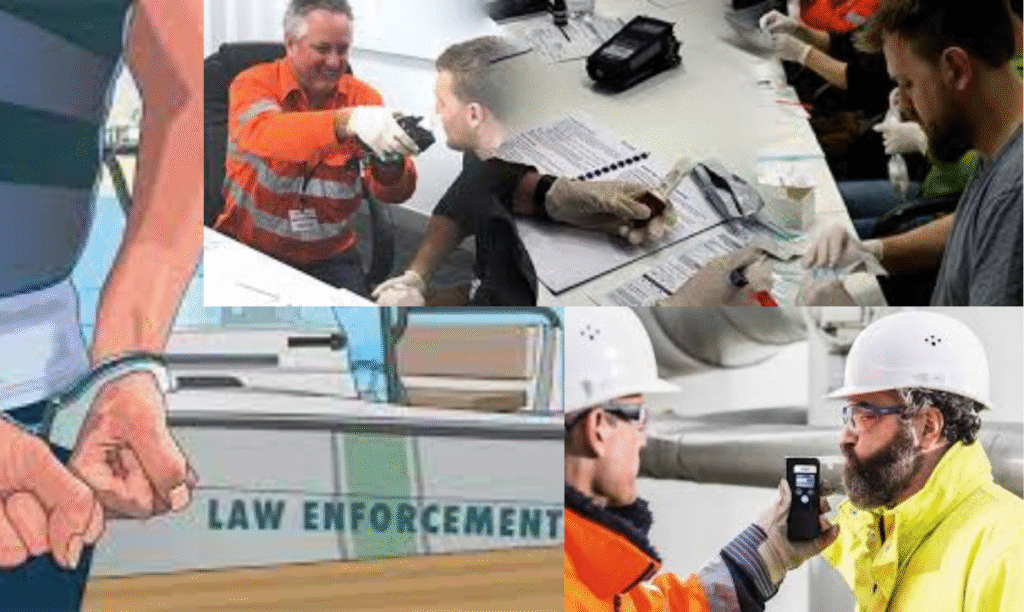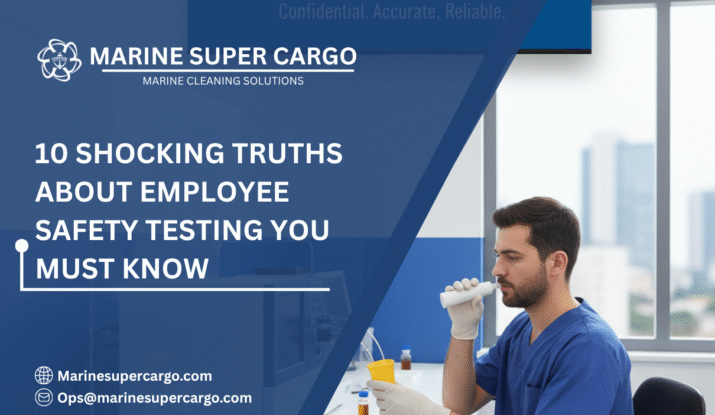Workplace safety goes beyond hard hats and warning signs—it begins with people. A safe environment depends on crew members being fit, alert, and responsible at all times. That’s why Employee Safety Testing is so essential.
Among its most vital forms, drug and alcohol testing acts as both a shield and a compass: shielding organizations from hidden risks like impaired judgment and accidents, while guiding them toward healthier, more reliable operations.
In the maritime sector, the stakes are even higher. A single lapse at sea can threaten lives, cargo, and the environment. For ship owners, operators, and safety managers, testing isn’t just about compliance—it’s a necessity for protecting people, assets, and reputations.
Why Employee Safety Testing Matters
Imagine sailing into open waters with a crew that isn’t fully alert. Even one impaired decision could turn calm waves into a storm of accidents, violations, and catastrophic costs. Employee Safety Testing, particularly drug and alcohol evaluations, steps in as the early-warning radar—catching risk before it escalates.
Key benefits include:
- Reduction of accidents and injuries
- Legal compliance with international safety standards
- Enhanced operational efficiency
- Strengthened company reputation
Testing goes beyond “catching” wrongdoers. It builds trust, ensures fairness, and fosters a culture of accountability—an environment where everyone looks out for each other.

The Scope of Drug & Alcohol Testing
Drug and alcohol testing, as part of Employee Safety Testing, has wide applications across industries but carries unique relevance in high-risk sectors like shipping, offshore operations, and heavy industry. Also, read about the Surveyor’s role during hull cleaning operations.
Common Testing Types
- Pre-Employment Testing – Ensures new hires meet safety and reliability standards.
- Random Testing – Acts as a deterrent, ensuring ongoing compliance.
- Post-Accident Testing – Determines if substance impairment contributed.
- Return-to-Duty Testing – Clears employees to resume work safely.
Each method strengthens the reliability of an organization’s workforce through transparent and fair evaluation.
Regulatory Framework & Compliance
Maritime operations fall under rigorous international governance. Organizations such as the International Maritime Organization (IMO), MARPOL Convention, and International Association of Ports and Harbors (IAPH) emphasize crew safety as non-negotiable.
Employee Safety Testing directly supports these standards:
- IMO guidelines highlight the importance of fitness for duty onboard vessels.
- MARPOL Convention underscores environmental risk, which substance abuse can indirectly magnify.
- IMCA (International Marine Contractors Association) promotes a safety culture through responsible workforce management.
Falling short in compliance doesn’t just risk fines; it jeopardizes the vessel, the crew, cargo, and fragile marine ecosystems.
The Link Between Testing and Operational Efficiency
Operational excellence is impossible without human reliability. When crews are impaired, minor mistakes become costly mishaps: delayed schedules, expensive cleanups, or even collisions.
Employee Safety Testing ensures:
- Fewer disruptions: By preventing incidents before they occur.
- Lower insurance premiums: Compliance reassures insurers of reduced liability.
- Extended asset life: Safe operations protect vessels, equipment, and cargo.
- Protected environment: Preventing avoidable spills aligns with MARPOL’s environmental commitments.
Think of Employee Safety Testing as preventive maintenance—not for engines but for the human factor that drives every vessel forward.
✅ 4 Things to Check for Safety at Sea pic.twitter.com/dAxhJQ2i6U
— Marine Super Cargo (@Marinsupercargo) September 14, 2025
Myths About Drug & Alcohol Testing
Like many safety measures, testing attracts myths and doubts. Let’s separate fact from fiction:
- “It invades privacy.” In reality, regulation frameworks ensure confidentiality and fairness.
- “It discourages employees.” Done correctly, it reassures responsible workers and deters risky behavior.
- “It’s too costly.” The cost of testing is negligible compared to an accident or regulatory penalty.
When viewed correctly, Employee Safety Testing is not punishment—it’s protection. Also read about Powerful Reasons Drug and Alcohol Testing Matters.
Future Trends in Employee Safety Testing
Advances in technology are reshaping how organizations safeguard employees.
- AI-powered risk analytics predict unsafe behavior patterns.
- Onboard digital tools enable real-time monitoring for fatigue and impairment.
- Non-invasive rapid tests make compliance faster and less disruptive.
- Integration with safety management systems (SMS) provides holistic workforce oversight.
These innovations will make Employee Safety Testing even more seamless, predictive, and worker-friendly.
Marine Supercargo Expands Services: Drug & Alcohol Testing for Safer Seas
Marine Supercargo, known worldwide for its marine cleaning expertise through its innovative CleanShip.co platform, has now expanded into professional Drug & Alcohol Testing services. This new development serves as a cornerstone for safer seas by helping shipowners, operators, and managers strengthen compliance and crew fitness.
The service ensures that maritime organizations meet strict international obligations under IMO, MARPOL, and IMCA regulations. Beyond just compliance, it enhances operational efficiency by preventing costly disruptions due to accidents or impaired decision-making. For today’s shipping industry, where safety and environmental responsibility go hand in hand, this is a timely move. Marine Supercargo’s initiative reflects the evolving needs of the maritime community—offering integrated solutions that protect both people and planet.

Practical Implementation Tips
So, how can you embed Employee Safety Testing into your operations effectively?
- Develop clear policies tied directly to international standards.
- Communicate openly with crews about the purpose and fairness of testing.
- Train supervisors to recognize impairment warning signs.
- Schedule audits to ensure compliance readiness.
- Leverage technology for secure reporting and record-keeping.
Implementation works best when viewed not as a box-tick but as part of a living safety culture.
Conclusion
Employee Safety Testing is more than just a regulation—it’s the backbone of safe, ethical, and cost-efficient operations. Drug and alcohol testing prevents accidents, protects reputations, and ensures responsibility across crews.
Key Takeaways:
- Testing safeguards compliance with IMO, MARPOL, and IMCA standards.
- It builds trust and accountability while deterring risky behaviors.
- Future innovations will make systems smarter, faster, and employee-friendly.
For shipowners, operators, and managers who want safer, greener seas, the future starts today. Explore integrated safety and testing solutions at CleanShip.co to ensure your operations move forward with confidence.
FAQs:
Q1. Why is drug and alcohol testing important for ships?
Drug and alcohol testing ensures crew members are alert, compliant, and capable of performing duties safely, reducing risks of accidents and protecting marine environments.
Q2. How does Employee Safety Testing align with IMO and MARPOL?
Testing supports IMO fitness-for-duty requirements and MARPOL’s environmental goals by preventing impairment-related incidents that could harm people and ecosystems.
Q3. What types of Employee Safety Testing are used in maritime operations?
Common types include pre-employment, random, post-incident, and return-to-duty tests, each designed to safeguard safety and meet compliance standards.
Q4. Can testing improve operational efficiency?
Yes. By reducing accidents, delays, and compliance risks, testing lowers costs, protects assets, and ensures vessels operate reliably.
Q5. Is Employee Safety Testing relevant beyond shipping?
Absolutely. While vital at sea, testing applies to aviation, heavy industry, construction, and energy—anywhere safety, compliance, and people matter most.


